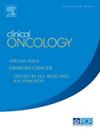巴西男性乳腺癌的特征和生存结果:基于人口的大型研究
IF 3.2
3区 医学
Q2 ONCOLOGY
引用次数: 0
摘要
目的:本研究评估了巴西圣保罗州男性乳腺癌(BC)的临床病理特征、治疗趋势和总生存率(OS):2000年1月至2020年6月期间确诊为浸润性乳腺癌的男性患者来自圣保罗肿瘤中心基金会数据库,该数据库包含巴西圣保罗州4600万居民的相关数据。根据年龄、教育程度、临床分期、治疗方式和医疗实践对患者进行了描述。分类变量以百分比和频率描述。采用考克斯比例危险回归模型将人口统计学、治疗因素和OS联系起来,同时考虑到不同的随访时间。Kaplan-Meier曲线用于显示生存曲线:结果:共纳入907名男性BC患者。诊断时年龄分布为 70 岁的患者分别占 21.5%、51.5% 和 27.0%。I、II、III 和 IV 期患者的比例分别为 19.5%、36.6%、31.5% 和 12.3%。I、II、III和IV期患者的5年和10年生存率分别为87.9%和77.8%、79.9%和58.9%、51.6%和24.5%、20.0%和5.6%。接受术后放疗的患者的OS明显改善(HR 0.67;95% CI 0.53-0.84;P < 0.001)。在对执业(公立或私立)、教育程度(低或中/高)、年龄、诊断分期和治疗方式进行调整后的多变量分析中,对OS有显著独立预测作用的因素是诊断分期:结论:男性乳腺癌患者往往在确诊时处于更晚期、年龄更大。年龄和受教育程度对生存结果没有影响。诊断时的分期和术后放疗是改善OS的相关因素。本文章由计算机程序翻译,如有差异,请以英文原文为准。
Characteristics and Survival Outcomes of Male Breast Cancer in Brazil: A Large Population-Based Study
Aims
This study evaluated the clinicopathological characteristics, treatment trends, and overall survival (OS) in male breast cancer (BC) in Sao Paulo State of Brazil.
Materials and methods
Men diagnosed with invasive breast cancer between January 2000 and June 2020 were identified from Fundação Oncocentro de Sao Paulo database encompasses data pertinent to 46 million residents of the Sao Paulo State of Brazil. Patients were described according to age, education level, clinical stage, treatment modalities, and medical practice. Categorical variables were described as percentages and frequencies. Demographic, treatment factors, and OS were associated using a Cox proportional hazard regression model while accounting for different lengths of participant follow-up. The Kaplan-Meier curves were used to display survival curves.
Results
A total of 907 male BC patients were included. The age distribution at diagnosis was <51 years, 51–70 years, and >70 years in 21.5%, 51.5% and 27.0% of patients, respectively. The proportions of stages I, II, III, and IV were 19.5%, 36.6%, 31.5%, and 12.3%. For each stage I, II, III, and IV, 5- and 10-years OS were 87.9% and 77.8%, 79.9% and 58.9%, 51.6% and 24.5%, 20.0% and 5.6%, respectively. Patients who received postoperative radiotherapy experienced a significant improvement in OS (HR 0.67; 95% CI 0.53–0.84; p < 0.001). In the multivariable analysis adjusted for practice (public or private), education (low or medium/high), age, stage at diagnosis, and treatment modalities, the significant independent predictor for OS was stage at diagnosis.
Conclusion
Male BC tends to be diagnosed at a more advanced stage and older age at the time of diagnosis. Age and educational level did not influence survival outcomes. Stage at diagnosis and the use of postoperative radiotherapy were factors associated with improved OS.
求助全文
通过发布文献求助,成功后即可免费获取论文全文。
去求助
来源期刊

Clinical oncology
医学-肿瘤学
CiteScore
5.20
自引率
8.80%
发文量
332
审稿时长
40 days
期刊介绍:
Clinical Oncology is an International cancer journal covering all aspects of the clinical management of cancer patients, reflecting a multidisciplinary approach to therapy. Papers, editorials and reviews are published on all types of malignant disease embracing, pathology, diagnosis and treatment, including radiotherapy, chemotherapy, surgery, combined modality treatment and palliative care. Research and review papers covering epidemiology, radiobiology, radiation physics, tumour biology, and immunology are also published, together with letters to the editor, case reports and book reviews.
 求助内容:
求助内容: 应助结果提醒方式:
应助结果提醒方式:


